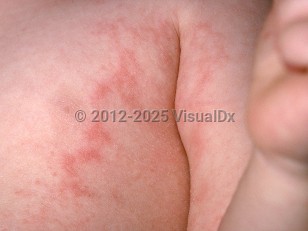Unilateral laterothoracic exanthem of childhood in Infant/Neonate
Alerts and Notices
Important News & Links
Synopsis

Unilateral laterothoracic exanthem (ULE), also known as asymmetric periflexural exanthem of childhood (APEC), is a self-limited exanthem commonly seen in early childhood. The etiology is unknown, but it is thought to be a cutaneous reactive process to viral infections, with the most common being parvovirus B19, Epstein-Barr virus (EBV), adenovirus, and SARS-CoV-2. Other reported associations include influenza, parainfluenza 2 and 3, human herpesvirus 6 and 7, molluscum contagiosum, poxvirus, rubeola, and Campylobacter jejuni. It has been hypothesized that a postzygotic mutation involving the keratinocytes on one side of the body contributes to the accentuated unilateral response.
ULE is more common in the late winter and early spring. It usually affects children aged 2-3 years (although it has been described in children aged 8 months to 10 years). It is predominantly seen in females, with a female-to-male ratio of 2:1. Although uncommon in adults, many cases have been reported following both COVID-19 infection and COVID vaccination (mRNA and recombinant) in both children and adults. The eruption tends to appear 2 days after vaccine administration. The Centers for Disease Control and Prevention (CDC) encourages subsequent COVID-19 vaccines, as the reaction is not considered a severe cutaneous reaction.
A prodrome of constitutional, upper respiratory, or gastrointestinal symptoms may precede the exanthem, which begins in an axilla (or the inguinal fold, or a popliteal or antecubital fossa) and spreads to involve the trunk and/or the extremities. Associated symptoms and signs include low-grade fever (40%) with mean occurrence on the sixth day, pruritus (65%), and lymphadenopathy (70%) located adjacent to the primary area of involvement.
The exanthem usually resolves within 3-6 weeks without cutaneous sequalae. Recurrence is unusual.
ULE is more common in the late winter and early spring. It usually affects children aged 2-3 years (although it has been described in children aged 8 months to 10 years). It is predominantly seen in females, with a female-to-male ratio of 2:1. Although uncommon in adults, many cases have been reported following both COVID-19 infection and COVID vaccination (mRNA and recombinant) in both children and adults. The eruption tends to appear 2 days after vaccine administration. The Centers for Disease Control and Prevention (CDC) encourages subsequent COVID-19 vaccines, as the reaction is not considered a severe cutaneous reaction.
A prodrome of constitutional, upper respiratory, or gastrointestinal symptoms may precede the exanthem, which begins in an axilla (or the inguinal fold, or a popliteal or antecubital fossa) and spreads to involve the trunk and/or the extremities. Associated symptoms and signs include low-grade fever (40%) with mean occurrence on the sixth day, pruritus (65%), and lymphadenopathy (70%) located adjacent to the primary area of involvement.
The exanthem usually resolves within 3-6 weeks without cutaneous sequalae. Recurrence is unusual.
Codes
ICD10CM:
B09 – Unspecified viral infection characterized by skin and mucous membrane lesions
SNOMEDCT:
49882001 – Viral exanthem
B09 – Unspecified viral infection characterized by skin and mucous membrane lesions
SNOMEDCT:
49882001 – Viral exanthem
Look For
Subscription Required
Diagnostic Pearls
Subscription Required
Differential Diagnosis & Pitfalls

To perform a comparison, select diagnoses from the classic differential
Subscription Required
Best Tests
Subscription Required
Management Pearls
Subscription Required
Therapy
Subscription Required
References
Subscription Required
Last Reviewed:03/04/2024
Last Updated:03/07/2024
Last Updated:03/07/2024
 Patient Information for Unilateral laterothoracic exanthem of childhood in Infant/Neonate
Patient Information for Unilateral laterothoracic exanthem of childhood in Infant/Neonate
Premium Feature
VisualDx Patient Handouts
Available in the Elite package
- Improve treatment compliance
- Reduce after-hours questions
- Increase patient engagement and satisfaction
- Written in clear, easy-to-understand language. No confusing jargon.
- Available in English and Spanish
- Print out or email directly to your patient
Upgrade Today

Unilateral laterothoracic exanthem of childhood in Infant/Neonate

